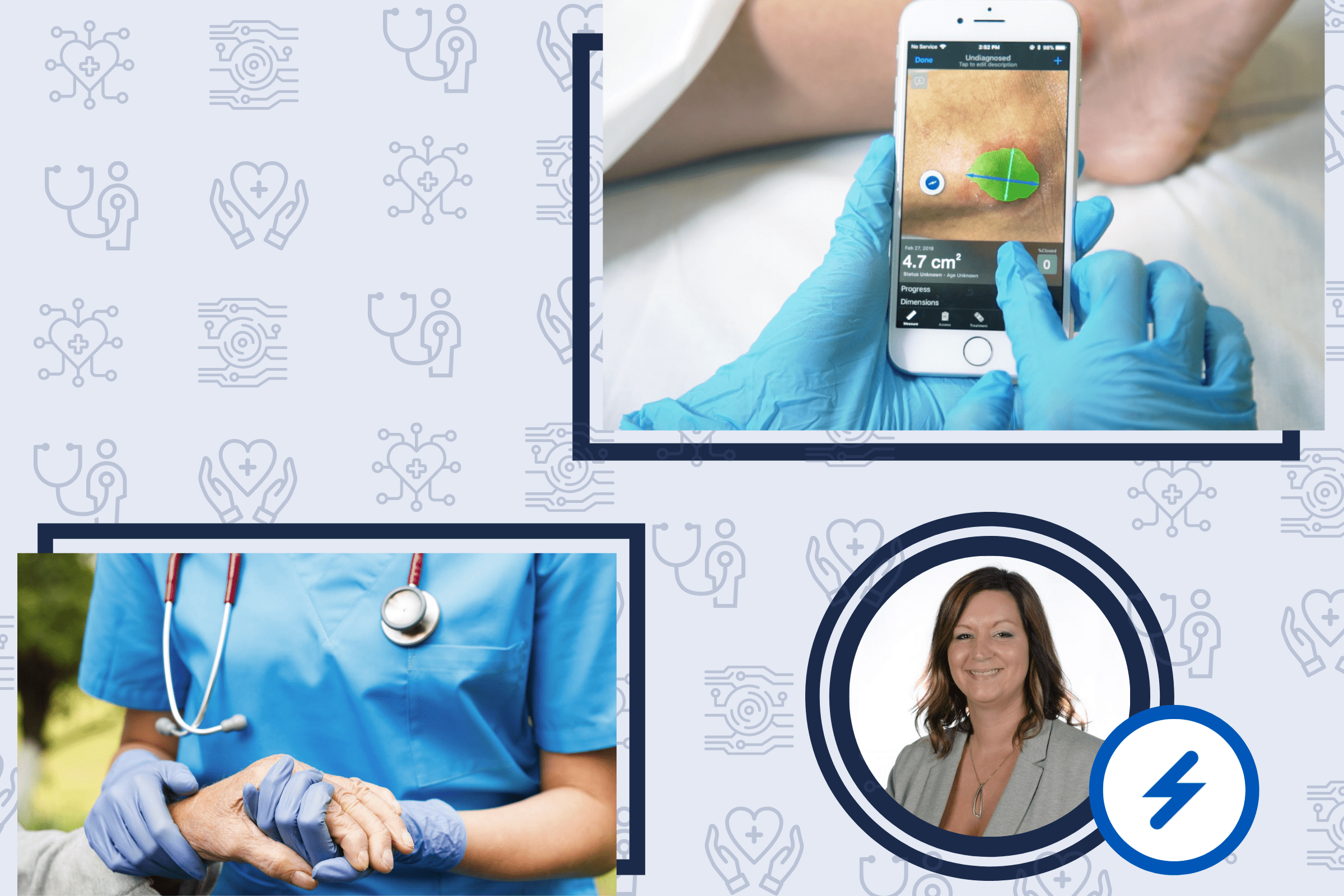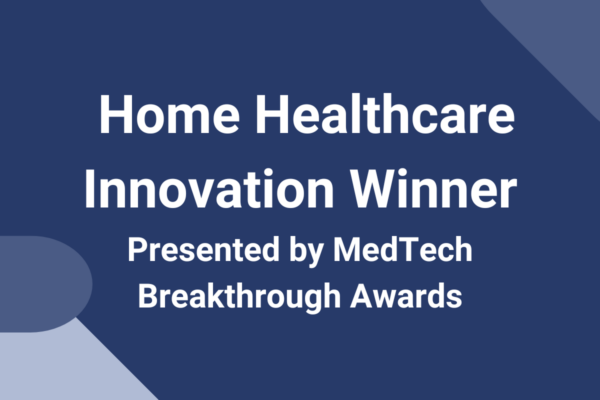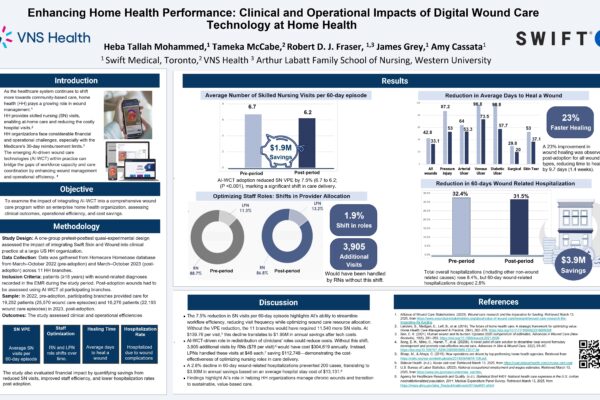We recently had a conversation with Swift Medical’s V.P. of Clinical Success, Amy Cassata, in which she shared her health care journey and the steps that brought her to Swift. As part of Swift’s forward-thinking team of professionals who have solved very difficult health care challenges, Amy is ideally placed to understand the problems faced by health care professionals from an administrative, nursing, and now innovation-focused lens. Here’s what Amy had to say:
You’ve been a health care professional for many years. Can you highlight the moments that led you to where you are today?
I’ve been in in health care for almost 20 years. I started with several years of direct nursing experience in post-acute long-term rehab and skilled nursing before working my way up to assistant director, director, and administrative director positions. That’s really where I was first exposed to wound care.
I took my first director of nursing job walking into three G-level citations – G-level citations mean the organization caused harm – and one of the reasons was related to wound care. I suddenly dropped into clinical operations management and wound care. It was a trial by fire, learning the policies, the rules, and the regulations. I cleared all my citations, and that became my niche. I was working with a wound care doctor, and I was known in my region as the person who can come help put a wound care program in place at your organization.
At the same time, I was sitting on a recidivism board at one of the hospitals, working collaboratively to keep patients out of the hospital and keep them in skilled nursing or home health. I wanted to find some different options that would let me build my career. I took a position as director of clinical operations, overseeing five facilities in multiple states, transitioning each from 100% paper to 100% electronic within a year.
How did you come to transition to the innovation side of health care, and what inspired you to make the leap and join Swift?
I have always been interested in novel approaches to fixing problems. At a conference, I saw Swift’s innovative technology, and I wanted to try it. I offered to have one of my skilled nursing facilities be a guinea pig for the technology, and then we loved it so much we rolled it out to the rest of my facilities. That was my first introduction to Swift – I used the product for more than two years before joining the company. Once we adopted Swift, we had high levels of compliance in all facilities, with no citations, and nothing legal related to skin and wound conditions.
In terms of joining Swift, I’m always up for a challenge! I also felt working with Swift would give me a broader impact on wound care. I had five facilities, 100 staff, and 500 residents, under my management, but how could I extend my reach beyond those buildings? I wanted to impact more patients’ lives across the country.
As an RN and a Director, what challenges have you faced in your day-to-day work?
Standardization is a significant challenge. There’s a range of education levels, experience levels, and technology levels in both wound care and in core nursing functions. When I was a nursing student, we didn’t have electronic medical records, we were taught on paper. Now, I’m asking people who have done the same thing for 25 years to do it differently. That can be a source of frustration, because as good as the technology is, it’s useless if I can’t get my staff to understand it and use it. That’s why it’s so important to have a solution that’s intuitive to use, fits within the nurses’ workflow and ultimately makes their job easier – otherwise they’ll never use the technology for more than a week. I had to remove that barrier of standardizing, then make sure that the nurses had the best resources at their fingertips.
What do you see as the biggest challenge today in wound care?
Wound care patients see multiple providers to receive care, making collaboration critical between clinicians. As a nurse, how do I bridge the gap between treatment standards held by the primary care provider, the infectious disease physician, all the other care providers? How do I get them all to agree to the standards of evidence-based practice that I want to institute in my organization? And how do I impart greater wound care knowledge to my nurses, so that they can provide better care and have more informed conversation with physicians?
What aspect of wound care needs the most attention right now? Where do you see the greatest potential for improvement?
If we can better support our nurses, we’re going to have better outcomes. When it comes to wound care, we still have to deal with a lack of understanding from the various health care practitioners across the healthcare continuum. For example, sometimes we see physicians ordering their own custom compounds. But nurses aren’t allowed to compound medication, so when a physician requests that, it’s something that’s out of my scope of practice. We have to empower nurses to understand how they can practice at the top of their license, to think critically and have a comprehensive conversation with the care provider.
What do you wish nursing professionals knew about technology and innovation as they relate to wound care?
I would like nurses to know that there is technology and innovation in wound care – that is both raising the quality of wound care and making wound care easier. Often when we think about technology and innovation in nursing, it’s in the ICU, critical care or acute nursing care. But a lot of those patients also have chronic wounds. How can technology help with the chronic piece, the long-term piece, the skilled nursing piece, or the home health piece, as it relates to wound care?
Technology is here to help, and nurses shouldn’t be afraid of it. They need to embrace it, but at their own speed. I’d tell nurses, “It’s o.k. to ask for help and ask questions. I would rather you ask a question and have me explain it to you. That way, I’ll get better buy-in from you, and you’ll get better buy-in from the technology, and you’ll trust that technology more.”
Are there myths or misconceptions about technology that you wish you could dispel?
Everyone thinks that technology is the solution to every problem! But it only works if it’s implemented for the right reasons, and it’s not going to result in change overnight. It’s o.k. that there are bumps in the road. I would always prefer that people ask about the technology early on, and take steps to understand it during that implementation process, rather than wonder why they’re doing something later on, just because they don’t understand it. Helping nurses understand the reasons behind a change will help them implement the change more successfully.
How have you been able to overcome nurses’ reluctance to use technology?
We’ve learned that we need to tailor programs for tactile learners, visual learners, and auditory learners, and we’ve adapted our implementation program at Swift so that it reaches all of those groups. We work with organizations to determine who’s a tactile learner, who’s visual, and who’s auditory, and we give them the training that best suits their needs. Most nurses learn by doing – that’s why clinicals are such an important part of nursing education – so that hands-on piece is huge.
One thing that has helped bridge the gap and quickly get a team on board is actually a short video. It’s a high-level overview of what Swift does, why nurses should be using photography, how it helps nurses care for their patients, and how it’s going to streamline back-office operations. We try to help nurses understand that this won’t require huge change management – like an EMR might – and that it won’t take up hours from their day. That’s very important to them, and we understand and acknowledge that.
Is there a trend or innovation in wound care that you’re especially excited about?
We’ve seen AI and deep machine learning used in different technologies in the hospitals, such as MRIs, CT scans, PET scans, and X-rays, but now we’re seeing true innovation come to wound care. These advanced technologies are helping us look at a patient’s comorbidities and their wound, assess the data related to that wound, and project that it should heal in X number of weeks. Technology is also helping us recommend different treatment types, based on the tissue in the wound.
All of these can improve patient happiness. They reduce pain associated with the wound, and can keep patients in their homes or in their preferred care setting. Using these advancements to help our patients is really exciting. By giving patients tools they can use to take better care of their wounds, we’re also helping them take back control of their lives.
Learn more about our clinically validated solution is making a difference in the lives of frontline clinicians and patients: book a demo with our team.





